2013 LINCOLN MKZ HYBRID warning
[x] Cancel search: warningPage 16 of 475
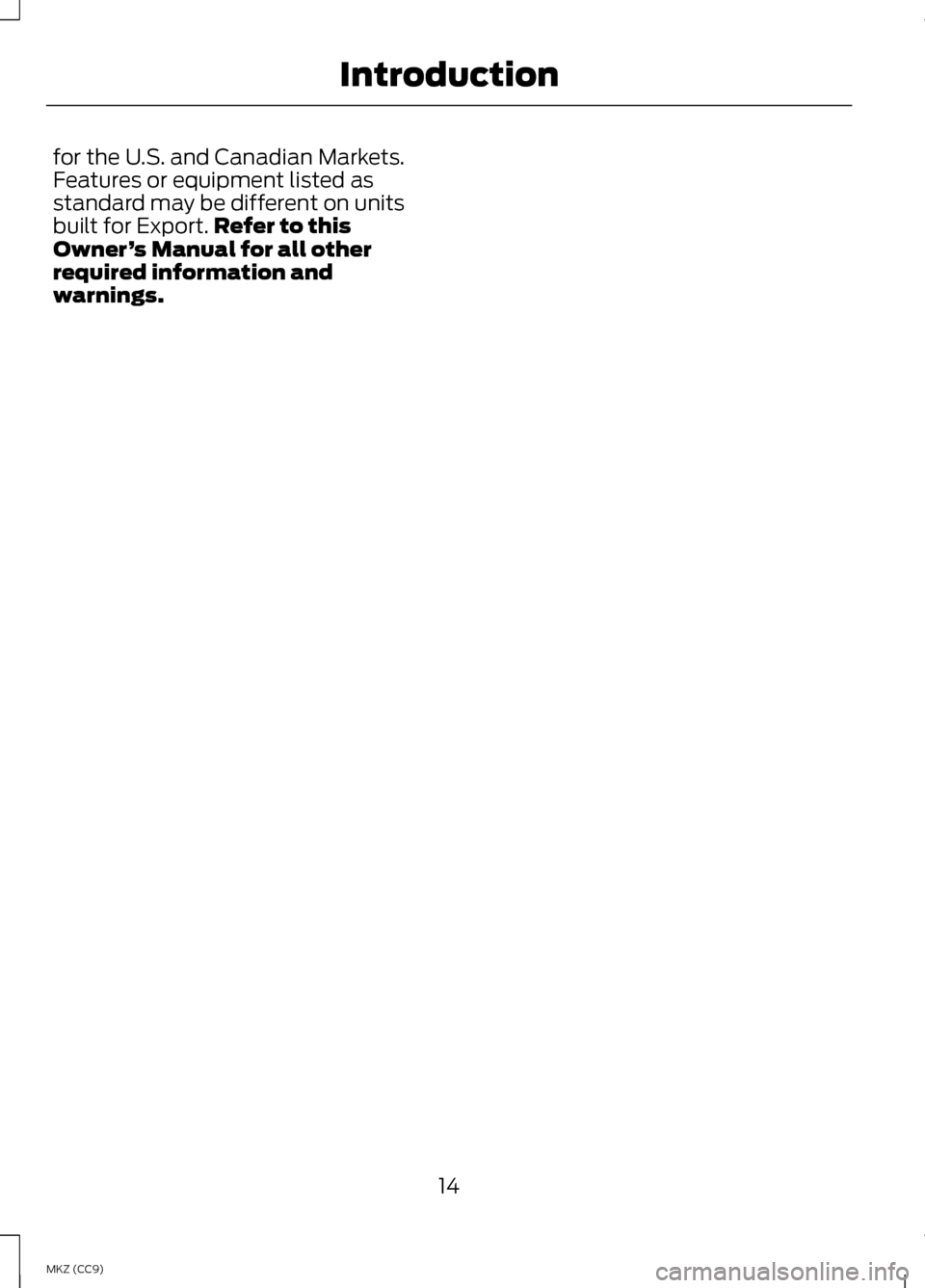
for the U.S. and Canadian Markets.
Features or equipment listed as
standard may be different on units
built for Export.
Refer to this
Owner ’s Manual for all other
required information and
warnings.
14
MKZ (CC9) Introduction
Page 17 of 475

GENERAL INFORMATION
See the following sections for
directions on how to properly use
safety restraints for children.
WARNINGS
Always make sure your child is
secured properly in a device that
is appropriate for their height, age and
weight. Child safety restraints must
be bought separately from your
vehicle. Failure to follow these
instructions and guidelines may result
in an increased risk of serious injury or
death to your child. All children are shaped
differently. The
recommendations for safety restraints
are based on probable child height,
age and weight thresholds from
National Highway Traffic Safety
Administration and other safety
organizations, or are the minimum
requirements of law. Ford
recommends checking with a NHTSA WARNINGS
Certified Child Passenger Safety
Technician (CPST) and consult your
pediatrician to make sure your child
seat is appropriate for your child, and
is compatible with and properly
installed in your vehicle. To locate a
child seat fitting station and CPST,
contact the NHTSA toll free at
1-888-327-4236 or go to
http://www.nhtsa.dot.gov. In Canada,
check with your local St. John
Ambulance office for referral to a
CPST or for further information,
contact your provincial ministry of
transportation, locate your local St.
John Ambulance office by searching
for St. John Ambulance on the
internet, or Transport Canada at
1-800-333-0371
(http://www.tc.gc.ca). Failure to
properly restrain children in safety
seats made especially for their height,
age, and weight may result in an
increased risk of serious injury or death
to your child. 15
MKZ (CC9) Child Safety
Page 19 of 475

•
You are required by law to properly
use safety seats for infants and
toddlers in the United States and
Canada.
• Many states and provinces require
that small children use approved
booster seats until they reach age
eight, a height of 4 feet 9 inches
(1.45 meters) tall, or 80 pounds
(36 kilograms). Check your local
and state or provincial laws for
specific requirements about the
safety of children in your vehicle.
• When possible, always properly
restrain children 12 years of age
and under in a rear seating position
of your vehicle. Accident statistics
suggest that children are safer
when properly restrained in the
rear seating positions than in a
front seating position. See Front
Passenger Sensing System
(page
45).
CHILD SEAT POSITIONING WARNINGS
Airbags can kill or injure a child
in a child seat. Never place a
rear-facing child seat in front of an
active airbag. If you must use a
forward-facing child seat in the front
seat, move the vehicle seat upon
which the child seat is installed all the
way back. When possible, all children
age 12 and under should be properly
restrained in a rear seating position. If
all children cannot be seated and
restrained properly in a rear seating
position, properly restrain the largest
child in the front seat. WARNINGS
Always carefully follow the
instructions and warnings
provided by the manufacturer of any
child restraint to determine if the
restraint device is appropriate for your
child's size, height, weight, or age.
Follow the child restraint
manufacturer's instructions and
warnings provided for installation and
use in conjunction with the
instructions and warnings provided by
your vehicle manufacturer. A safety
seat that is improperly installed or
utilized, is inappropriate for your
child's height, age, or weight or does
not properly fit the child may increase
the risk of serious injury or death. Never let a passenger hold a
child on his or her lap while your
vehicle is moving. The passenger
cannot protect the child from injury in
a crash, which may result in serious
injury or death. Never use pillows, books, or
towels to boost a child. They can
slide around and increase the
likelihood of injury or death in a crash. Always restrain an unoccupied
child seat or booster seat. These
objects may become projectiles in a
crash or sudden stop, which may
increase the risk of serious injury. Never place, or allow a child to
place, the shoulder belt under a
child's arm or behind the back
because it reduces the protection for
the upper part of the body and may
increase the risk of injury or death in a
crash.
17
MKZ (CC9) Child Safety
Page 20 of 475

WARNINGS
To avoid risk of injury, do not
leave children or pets WARNINGS
unattended in your vehicle. Use any attachment method as indicated below by X
Combined
child and seat
weight
Restraint
Type Safety
belt only
Safety
belt and LATCH(lower
anchors and top tether
anchor)
Safety
belt and
top tether anchor
LATCH
(lower
anchors only)
LATCH
(lower
anchors and top tether
anchor)
X
X
Up to 65
lb (29 kg)
Rear
facing
child seat
X
Over 65
lb (29 kg)
Rear
facing
child seat
X
X
X
Up to 65
lb (29 kg)
Forward
facing
child seat
X
X
Over 65
lb (29 kg)
Forward
facing
child seat
Note: The child seat must rest tightly
against the vehicle seat upon which it
is installed. It may be necessary to lift
or remove the head restraint. See
Seats (page 143). BOOSTER SEATS WARNING
Never place, or allow a child to
place, the shoulder belt under a
child's arm or behind the back
because it reduces the protection for
the upper part of the body and may
increase the risk of injury or death in a
collision. 18
MKZ (CC9) Child Safety
Page 23 of 475
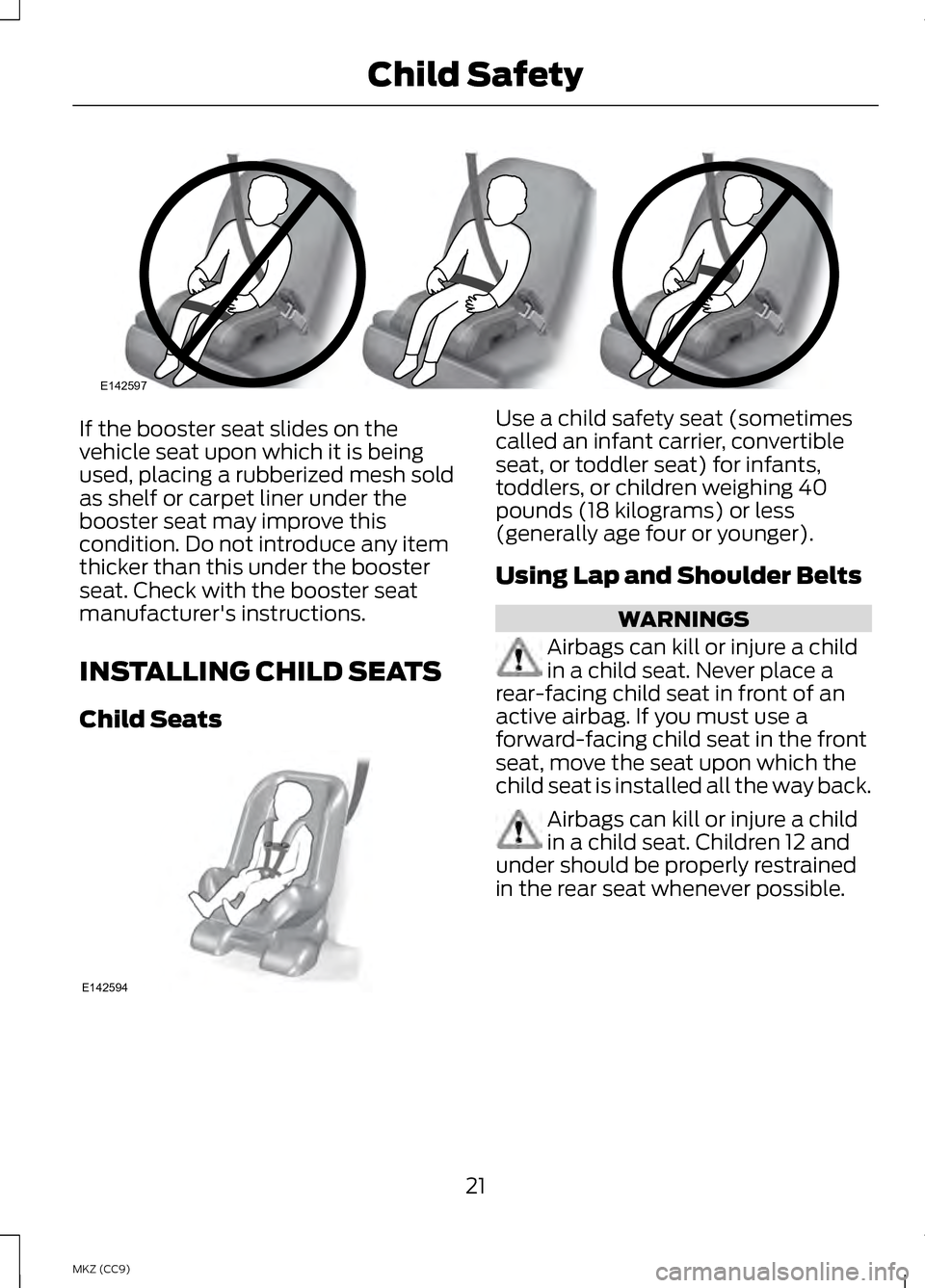
If the booster seat slides on the
vehicle seat upon which it is being
used, placing a rubberized mesh sold
as shelf or carpet liner under the
booster seat may improve this
condition. Do not introduce any item
thicker than this under the booster
seat. Check with the booster seat
manufacturer's instructions.
INSTALLING CHILD SEATS
Child Seats Use a child safety seat (sometimes
called an infant carrier, convertible
seat, or toddler seat) for infants,
toddlers, or children weighing 40
pounds (18 kilograms) or less
(generally age four or younger).
Using Lap and Shoulder Belts
WARNINGS
Airbags can kill or injure a child
in a child seat. Never place a
rear-facing child seat in front of an
active airbag. If you must use a
forward-facing child seat in the front
seat, move the seat upon which the
child seat is installed all the way back. Airbags can kill or injure a child
in a child seat. Children 12 and
under should be properly restrained
in the rear seat whenever possible.
21
MKZ (CC9) Child SafetyE142597 E142594
Page 24 of 475
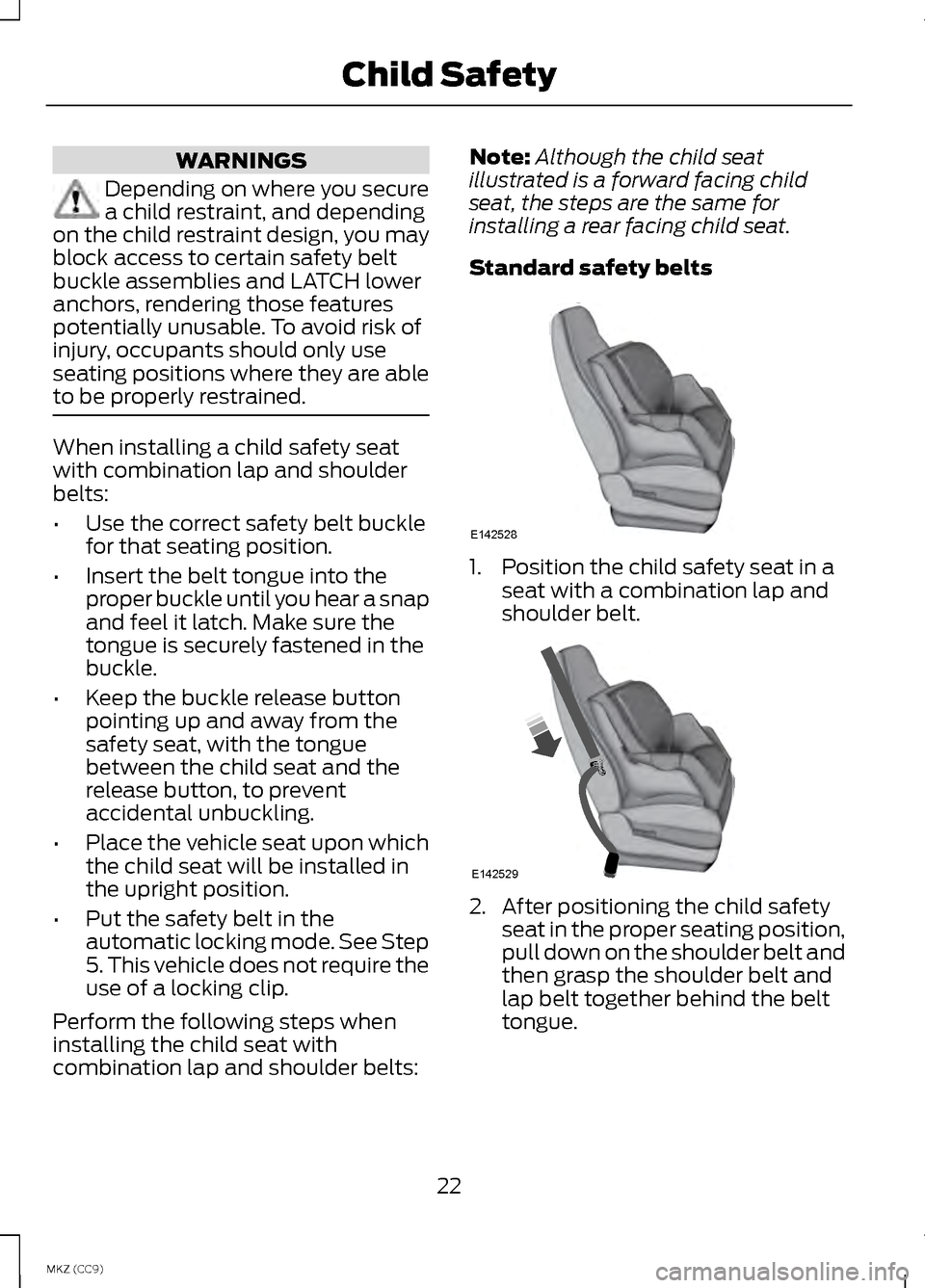
WARNINGS
Depending on where you secure
a child restraint, and depending
on the child restraint design, you may
block access to certain safety belt
buckle assemblies and LATCH lower
anchors, rendering those features
potentially unusable. To avoid risk of
injury, occupants should only use
seating positions where they are able
to be properly restrained. When installing a child safety seat
with combination lap and shoulder
belts:
•
Use the correct safety belt buckle
for that seating position.
• Insert the belt tongue into the
proper buckle until you hear a snap
and feel it latch. Make sure the
tongue is securely fastened in the
buckle.
• Keep the buckle release button
pointing up and away from the
safety seat, with the tongue
between the child seat and the
release button, to prevent
accidental unbuckling.
• Place the vehicle seat upon which
the child seat will be installed in
the upright position.
• Put the safety belt in the
automatic locking mode. See Step
5. This vehicle does not require the
use of a locking clip.
Perform the following steps when
installing the child seat with
combination lap and shoulder belts: Note:
Although the child seat
illustrated is a forward facing child
seat, the steps are the same for
installing a rear facing child seat.
Standard safety belts 1. Position the child safety seat in a
seat with a combination lap and
shoulder belt. 2. After positioning the child safety
seat in the proper seating position,
pull down on the shoulder belt and
then grasp the shoulder belt and
lap belt together behind the belt
tongue.
22
MKZ (CC9) Child SafetyE142528 E142529
Page 28 of 475
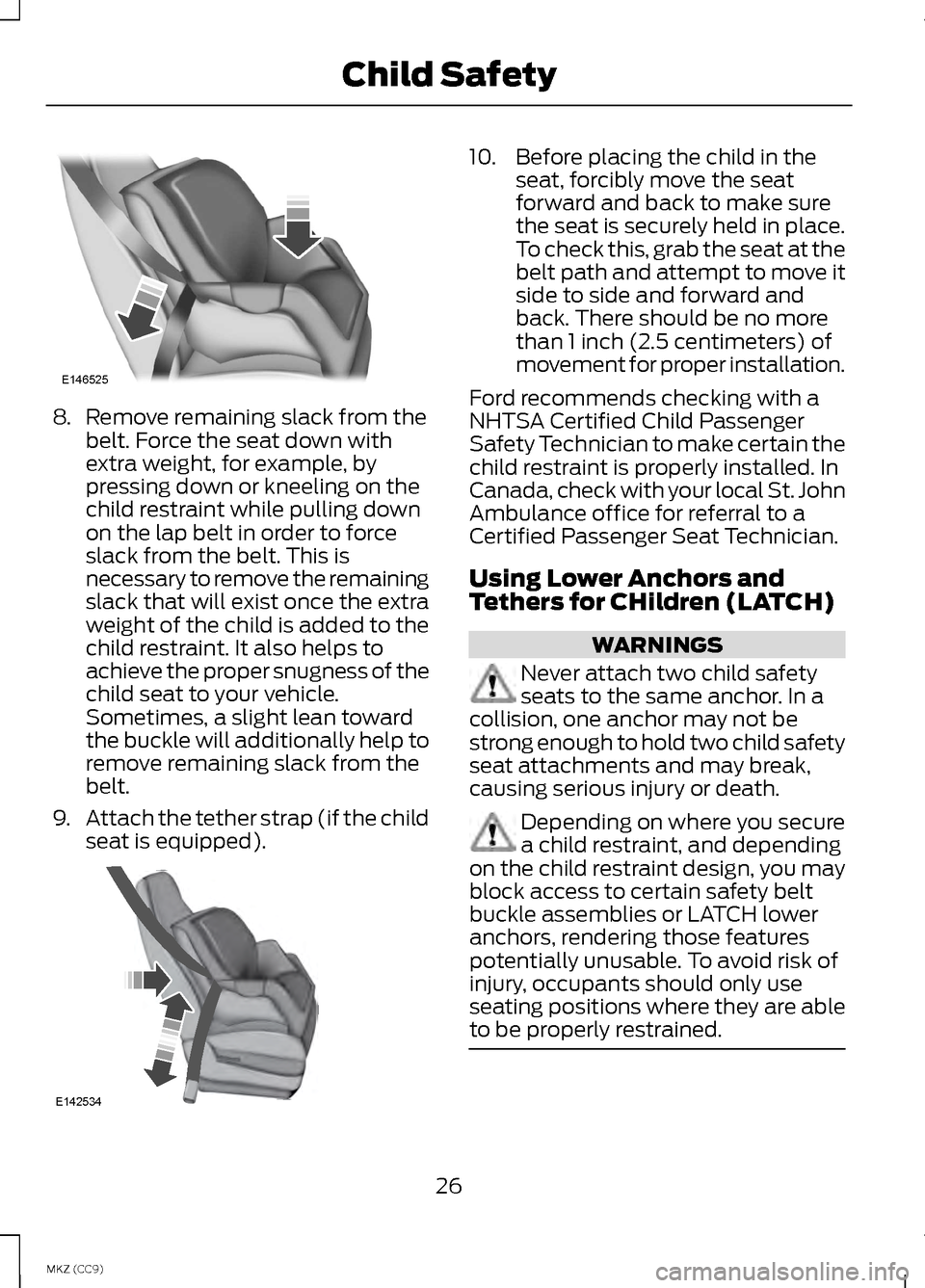
8.
Remove remaining slack from the
belt. Force the seat down with
extra weight, for example, by
pressing down or kneeling on the
child restraint while pulling down
on the lap belt in order to force
slack from the belt. This is
necessary to remove the remaining
slack that will exist once the extra
weight of the child is added to the
child restraint. It also helps to
achieve the proper snugness of the
child seat to your vehicle.
Sometimes, a slight lean toward
the buckle will additionally help to
remove remaining slack from the
belt.
9. Attach the tether strap (if the child
seat is equipped). 10. Before placing the child in the
seat, forcibly move the seat
forward and back to make sure
the seat is securely held in place.
To check this, grab the seat at the
belt path and attempt to move it
side to side and forward and
back. There should be no more
than 1 inch (2.5 centimeters) of
movement for proper installation.
Ford recommends checking with a
NHTSA Certified Child Passenger
Safety Technician to make certain the
child restraint is properly installed. In
Canada, check with your local St. John
Ambulance office for referral to a
Certified Passenger Seat Technician.
Using Lower Anchors and
Tethers for CHildren (LATCH) WARNINGS
Never attach two child safety
seats to the same anchor. In a
collision, one anchor may not be
strong enough to hold two child safety
seat attachments and may break,
causing serious injury or death. Depending on where you secure
a child restraint, and depending
on the child restraint design, you may
block access to certain safety belt
buckle assemblies or LATCH lower
anchors, rendering those features
potentially unusable. To avoid risk of
injury, occupants should only use
seating positions where they are able
to be properly restrained. 26
MKZ (CC9) Child SafetyE146525 E142534
Page 29 of 475
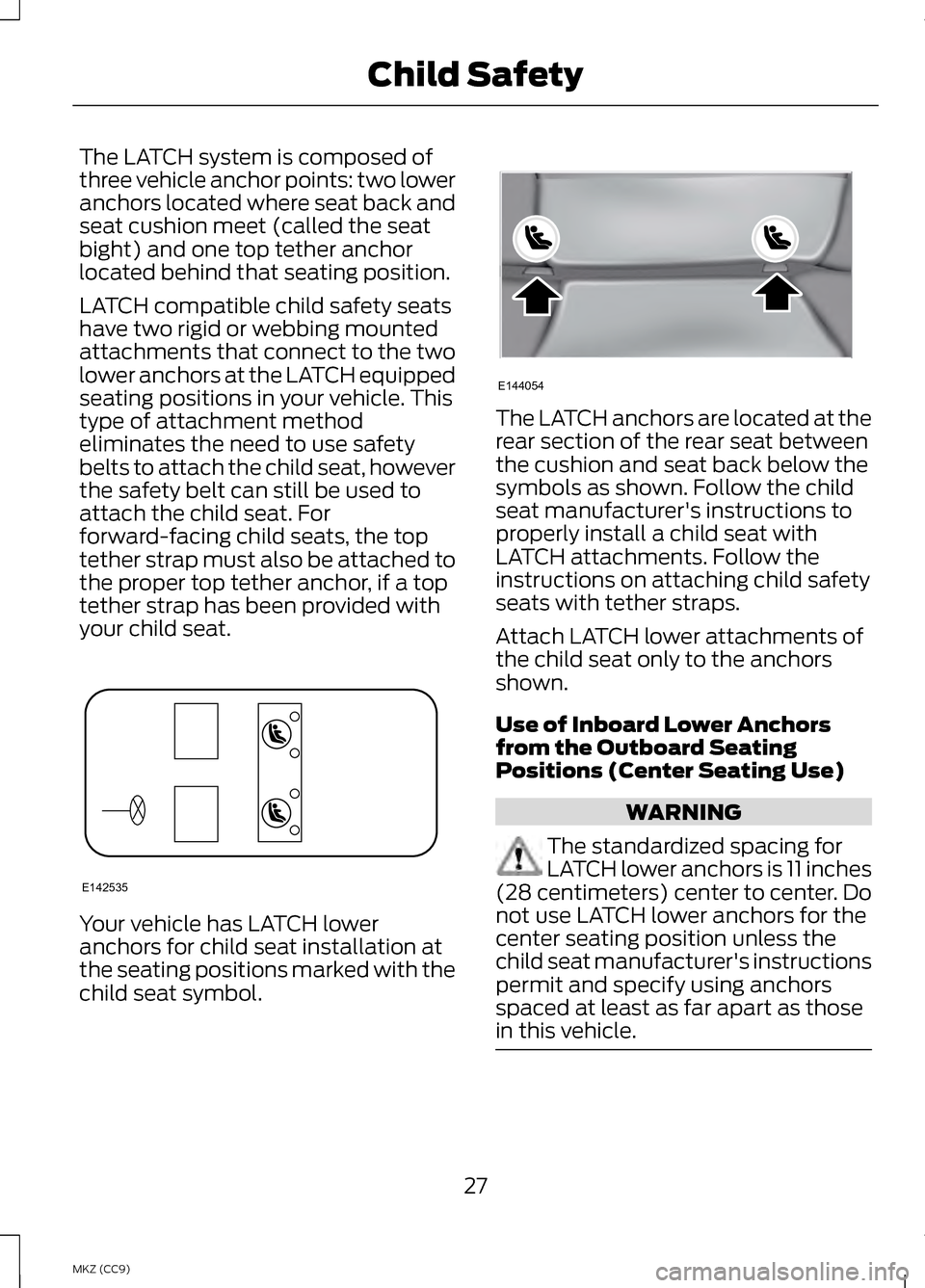
The LATCH system is composed of
three vehicle anchor points: two lower
anchors located where seat back and
seat cushion meet (called the seat
bight) and one top tether anchor
located behind that seating position.
LATCH compatible child safety seats
have two rigid or webbing mounted
attachments that connect to the two
lower anchors at the LATCH equipped
seating positions in your vehicle. This
type of attachment method
eliminates the need to use safety
belts to attach the child seat, however
the safety belt can still be used to
attach the child seat. For
forward-facing child seats, the top
tether strap must also be attached to
the proper top tether anchor, if a top
tether strap has been provided with
your child seat.
Your vehicle has LATCH lower
anchors for child seat installation at
the seating positions marked with the
child seat symbol. The LATCH anchors are located at the
rear section of the rear seat between
the cushion and seat back below the
symbols as shown. Follow the child
seat manufacturer's instructions to
properly install a child seat with
LATCH attachments. Follow the
instructions on attaching child safety
seats with tether straps.
Attach LATCH lower attachments of
the child seat only to the anchors
shown.
Use of Inboard Lower Anchors
from the Outboard Seating
Positions (Center Seating Use)
WARNING
The standardized spacing for
LATCH lower anchors is 11 inches
(28 centimeters) center to center. Do
not use LATCH lower anchors for the
center seating position unless the
child seat manufacturer's instructions
permit and specify using anchors
spaced at least as far apart as those
in this vehicle. 27
MKZ (CC9) Child SafetyE142535 E144054